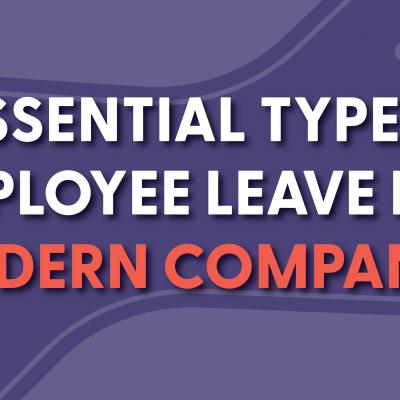As organizations seek to streamline operations, reduce turnover, and drive productivity, more and more are finding the value in offering comprehensive leave policies that provide their employee population with support in a way that matters to them.
Effective leave policies, after all, only work if both your business objectives are met and employees feel like their work-life balance isn’t being compromised.
While it’s intuitive to think that offering better leave policies would lead to better employee engagement, SHRM put some data behind that claim finding that 60% of employers found that offering paid parental leave alone increased their employee engagement.
Match that with our friends at Deloitte who released a study showing that, “Organizations with highly engaged employees experienced a 3-year revenue growth rate 2.3 times greater than average,” and it’s clear to see that better policies lead to better engagement which leads to higher revenues.
If you’re unclear if your policies are up to snuff, we’re breaking down 14 types of employee leave you should be considering implementing at your organization if you aren’t already. That first paragraph seems like forever ago, we know, but it’s important to note that it’s not the number of leave policies that will make a difference, but finding from the source which leave policies matter to your people, and streamlining the leave process for them.
This list extends beyond more common policies like holidays, PTO or sick time, and can be used as a guide for crafting future policies. It is always wise to seek legal counsel when drafting and finalizing your company leave policies.
Leave Policies Your Organization Should Be Considering
1&2) Parental leave: Are we cheating by counting parental leave as 1 & 2? Not entirely, but maybe a little. Many organizations don’t offer paid parental leave today, and some only offer the leave to a birthing parent, while others may break it down as maternity and paternity leave. It’s important to understand how much labels matter here.
Where “maternity” infers mom and “paternity” infers dad, parental leave includes all caregivers, regardless of gender. We’re starting off with parental leave because it’s a best practice to remove potentially biased language from your policies, so if you currently have two separate policies for parental leave (or none at all), combining them into one is the way to go.
3) Bereavement Leave: Leaves of absence for a positive life event can still cause significant disruption to the lives of your employees. There are many times, however, where life takes an unexpected turn for the worse. When that happens, employees expect a level of understanding from their employer that it’s encouraged to step away from work for a while. Employees dedicate such a significant amount of their life to their employer, so providing paid or unpaid time off for them to deal with the death of a close family member is going to matter tremendously to your people.
4) Jury Duty Leave: There are two types of people in this world, those who dread Jury Duty and those who want all the juicy details and have maybe listened to 2,348 murder mystery podcast episodes. We’re not here to assume which one you are, but outlining a clear jury duty leave policy ensures that your employees can participate in the judicial system without facing adverse employment consequences.
5) Miscarriage leave: While the FMLA states that eligible employees have the right to take 12 weeks of unpaid, job-protected leave to care for serious health conditions, including miscarriage and stillbirth, modern organizations are taking a proactive approach and spelling out a specific leave policy for miscarriage.
The truth is, oftentimes it’s unclear for employees when or if they can take a leave for a miscarriage, and the stigmas around it can keep employees from even bringing it up. We aren’t just saying that either, FastCompany recently shared a study from InHerSight that shows “77% of respondents said they didn’t know about the protection, and 91% of people who’ve had a miscarriage or stillbirth said they took zero days off from work to recover.”
6) Military Leave: Social media posts on Veterans Day or the 4th of July are nice, but what’s really nice is providing a clear military leave policy for your employees. Military leave is typically a job-protected type of employee leave that allows individuals who are members of the military, including the reserves or National Guard, to fulfill their military duties without jeopardizing their civilian employment. If you’re looking to go a step beyond that, provide a type of leave for partners of those in the military who might need to relocate, or spend time with their significant other before deployment.
7) Religious Holidays Leave: Inclusion matters. It matters to your employees and thus it should matter to your leadership. Providing a policy that allows individuals to take time off from work to observe and celebrate religious holidays that are not part of the standard company holiday schedule can do wonders toward making people from all walks of life feel welcome in the workplace. Accommodating employees’ diverse religious practices ensures they can participate in their religious traditions without any adverse work-related consequences.
8) Domestic Violence Leave: Offering support to individuals who are victims of domestic violence is a tremendous act of compassion. Employees may need to address the physical, emotional, or legal consequences of domestic violence, all of which can totally envelop their lives. Further, they may require medical attention, counseling, or legal assistance, and make safety arrangements. Some employees may not seek the change in life that they need because they fear repercussions in their employment. Providing this leave could quite literally save someone’s life.
9) Sabbatical Leave: There are several ways in which to craft a Sabbatical Leave policy, though typically this type of leave is reserved for employees with several years of service under their belt. Sabbatical leaves are typically longer-term, often unpaid leave for personal development, travel, or education. It allows your longest-tenured employees to recharge, seek out new ideas and professional development opportunities, and since it’s not the most common type of leave, could be a competitive hiring advantage.
10) Adoption Leave: While there is no specific adoption leave act, adoptive families are protected under FMLA regulations, so as long as you’re a covered organization and the employee is FMLA eligible they are likely protected by the law to take leave for an adoption. As an organization, you can also provide a paid leave policy for adoptive parents to bond with their new child as well. Doing so promotes a company culture that demonstrates it’s support of building a family, no matter the circumstances.
11) Mental Health Leave: A recent study of 515 in-house lawyers, C-suite executives and HR professionals found that “65% of respondents report receiving an increase in requests for disability accommodations and leaves of absence related to mental health conditions/issues since the start of 2022.” It’s more important than ever that your leave policies address supporting your employees by providing paid or unpaid time off to address mental health concerns or burnout.
12) Compassionate Leave: This leave type is typically created to provide individuals with the opportunity to take time off from work to attend to urgent and critical family matters. These may include caring for a seriously ill family member or dealing with a family emergency. Whether paid or unpaid, allowing employees to prioritize their family’s well-being during challenging times can do wonders to make your employees feel their life outside of work is valued.
13) Educational Leave: Most employers want smarter employees. Providing educational leave empowers employees to take time off from work to pursue further education or training that is related to their job or career development. It’s typically granted with the intention of enhancing the employee’s skills, knowledge, and qualifications, that way it benefits both the employee and your organization in the long run.
14) Election Day Leave: Election Day leave, also known as voting leave, is a type of employee leave that allows individuals to take time off from work to cast their votes in local, state, or national elections. This leave is often granted to ensure that employees have the opportunity to exercise their civic duty and participate in the democratic process without any adverse work-related consequences.
How to Administer Leave Policies Efficiently
Another best practice has less to do with the quantity of policies and more to do with the quality. A collaborative crafting approach is a fantastic way to involve your employees in the development of leave policies that truly resonate with their needs. Conduct surveys or hold open forums to gather input on existing policies and identify areas for improvement.
This approach ensures that policies are not only compliant with legal requirements but also reflect the diverse needs of your workforce. Not only that, involving employees in shaping leave policies builds trust, helps you identify potential biases in language, and leads to policies that genuinely address your employees’ concerns.
About Tilt
Tilt is leading the charge in all things leave of absence management through easy-to-use tech and human touch. Since 2017, our proprietary platform and Empathy Warriors have been helping customers make leave not suck by eliminating administrative burdens, keeping companies compliant, and providing a truly positive and supportive leave of absence experience for their people.







